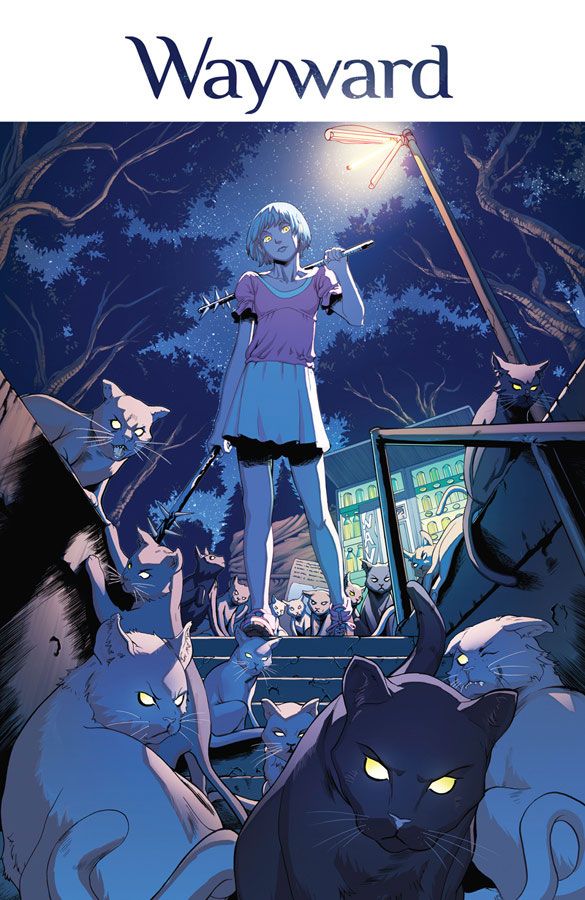When she moved to Japan to be with her mother, Rori Lane knew it would be a lot different from her life in Ireland -- but she never would have bargained on the supernatural attacks headed her way. Faced with a new country, a new lifestyle and a developing super ability, Rori barely gets the chance to adjust before she's thrown into a conflict between two powerful mythological forces. Jim Zub and Steve Cummings' "Wayward" #1 gets a strong start with a spunky young protagonist, incredibly meticulous artwork, and phenomenal coloring.
Coming out of a rather untraditional background, Rori has a lot of explaining to do within the first few pages: who she is, where she's from, where she's going, why she's moving and other vital plot information. Zub, Cummings and letterer Marshall Dillon accomplish this with as much fluidity as is possible, motoring her along her travels from the plane to the train to the subway and finally through her mother's home town of Tokyo. Zub's first person introduction for Rori is rather wordy, something that Dillon deals with spectacularly by slipping the narration boxes in smoothly but unobtrusively; likewise, her intended audience (and thereby her reason for telling the story this way) is unclear. However, this compact device gets the opening over with quickly and efficiently in its slow build, leaving much more room for the action and fun that kicks off in the latter half of the issue. Additionally, Zub cements her tone of voice and mood, organically relaying her fear, excitement, and youthful anger. Though Rori's mother comes across as stiff in her speech despite it being her native tongue, he flexes his naturalistic dialogue through Rori and later Ayane (who is her own ball of wacky, kickass fun).
With astonishing detail, Cummings breathes life into Tokyo by creating a city that feels not only huge and new but lived in. Not one background relies on a color fill to save space; each panel just overflows with minute details. Cummings shoulders a lot of the world building here, as Zub takes a very character-driven approach through the narration and dialogue, but his delivery is impeccable. He includes dozens of figures, consistently surrounding Rori with crowds of distinct figures. Cummings' scenery is simply thoughtful and impeccable.
In comparison to his scene building, however, his attention to the central characters could be stronger. Although some instances are (there are no other words for it) perfect, like Ayane's maniacal glee, his expression work with Rori and her mother comes across as mismatched or not strong enough. Similarly, Rori's size fluxuates next to her mother in a few panels where perspective isn't taken into account. Nevertheless, he has some very promising sequences, like the slow reveal of Rori's face in the beginning, her clear frustration when speaking with her mother, and finally her fear and confusion during the fight. Further, his costume and creature designs are delightfully bizarre. His style, particularly in his figure work, walks a thin line between mainstream superhero comics and manga, which -- for a story that involves a character caught between two cultures -- aptly suits the book.
As I debated on the score to give this book, colorist John Rauch -- with help from Zub -- sealed the deal. It is, in a word, brilliant. Together, they make Rori stand apart in a crowd, and not just for her vivid red hair. Everything about her -- from her clothes to her skin tone -- is subtly a shade or two brighter than her surroundings, allowing the reader to follow her naturally as she wends her way across the city. That isn't to say, of course, that the scenery is dark or muddied because of this. In fact, her world is just as packed with lively color, bringing a fun, invigorating atmosphere to the book as a whole. In direct comparison, Rori's path-o-vision -- her path-finding ability -- calls for a stark contrast in negative, bringing Tokyo to an almost alien level and thrusting its strangeness on the reader, if only for a panel.
With a stellar creative team, "Wayward" #1 has a lot going for it, reading like a fantastical "Buffy the Vampire Slayer"-meets-Studio Ghibli film with an R-rated twist. Bright, vibrant, and alive, Rori Lane's world will enchant readers with its relatable protagonist, intense action and fascinating mythological allusions.

